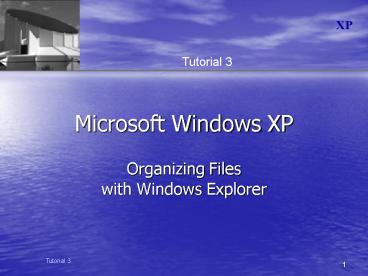Microsoft Windows XP - PowerPoint PPT Presentation
1 / 24
Title:
Microsoft Windows XP
Description:
Windows Explorer is divided into two sections called panes ... WordPad window. Click the Paste button to insert the image of the Windows Explorer window into ... – PowerPoint PPT presentation
Number of Views:52
Avg rating:3.0/5.0
Title: Microsoft Windows XP
1
Microsoft Windows XP
Tutorial 3
- Organizing Files with Windows Explorer
2
Windows Explorer
- Windows Explorer is a program included with
Windows XP that is designed to simplify file
management tasks
3
Displaying the Explorer Bar
- On the View menu point to Explorer Bar
- Windows Explorer is divided into two sections
called panes - The left pane (Explorer bar) shows different ways
of locating specific folders or folders on your
computer - You can display the Explorer bar in one of five
ways as a Search, Favorites, Media, History, or
Folders pane
4
Working with the Folders Pane
- Click the plus box next to a device or folder to
display its next level of folders - Click the minus box next to a device or folder to
hide all its subfolders - Storage device icons
5
The Folders Pane Displaying Folders on Drive A
6
Selecting an Object in the Folders Pane
- To select a device or folder, you must click its
icon, not its plus or minus box
7
Creating a New Folder
- In the Folders pane, click the device or folder
that will contain the new folder - Click File, point to New, and then click Folder
- Type a name for the new folder, and then press
the Enter key
8
Adjusting the Width of the Explorer Bar
- Move the mouse pointer to the dividing bar
between the left and right panes - When the arrow-shaped pointer changes to a
double-headed arrow, hold down the left mouse
button and drag the dividing line right or left,
as necessary - When the dividing bar is in the desired position,
release the mouse button
9
Adjusting the Width of the Explorer Bar
10
Selecting Files
- Make sure the right pane displays the files you
want to select - To select a single file, click the file
- To select consecutive files in a list of files,
select the first file and them press the Shift
key while you select the last file in the list - To select nonconsecutive files in a list, select
the first file and then press the Ctrl key while
you select each additional files - To select all the files and folders in the
selected device or folder, click Edit and then
click Select All
11
Printing the Windows Explorer Window
- Press the Print Screen key
- Start WordPad and maximize the WordPad window
- Click the Paste button to insert the image of the
Windows Explorer window into the document - Click the Print button
12
Printing the Windows Explorer Window
13
Moving Files with Cut and Paste
- Select the file or files you want to copy or move
- Click the Cut command on the Edit menu to move
the files, or click the Copy command on the Edit
menu to copy the selected file(s) - Select the device or folder in which you want to
place the copied or cut files - Click Edit on the menu bar, and then click the
Paste command
14
Moving or Copying Files with the Move To Folder
and Copy To Folder Commands
- Select the file or files you want to move
- Click Edit on the menu bar, and then click Move
To Folder - In the Move Items dialog box, locate and click
the folder to which you want to move the files - Click the Move button
15
Preparing a Disk with Quick Format
- Place your disk in drive A
- Right-click the 3½ Floppy (A) in the Folders
pane - Click Format on the shortcut menu to open the
Format 3½ Floppy (A) dialog box - Click the Quick Format check box
- Click the Start button
16
Copying a File to the Hard Disk and then to a
Different Floppy Disk
17
Working with the Favorites Pane
- If you want quick access to files and folders,
you can add them to the Favorites pane - To add a folder to the Favorites pane, you open
the folder in Windows Explorer, click Favorites
on the menu bar, and then click Add to Favorites - To add a file to the Favorites pane, open the Add
Favorite dialog box and drag one or more files
from the right pane to the Favorites pane
18
Adding Files to the Favorites Pane
19
Organizing the Favorites Pane
20
Working with the Media Pane
- Use can use the Media pane in the Windows
Explorer window to access multimedia files, such
as music and video files
21
Viewing Your File History
- The History pane displays a history of the files
and objects that youve opened recently - Like the Folders pane, the History pane is
available on the Explorer Bar
22
Other Views in the History Pane
23
Using the Search Companion Pane in Windows
Explorer
- In the Search Companion pane, you can specify the
name or part of a name of any file on your
computer, and Windows Explorer will then locate
the file for you - You can access the Search Companion pane by
clicking the Search button on the Standard
Buttons toolbar
24
Searching for Files in Windows Explorer































